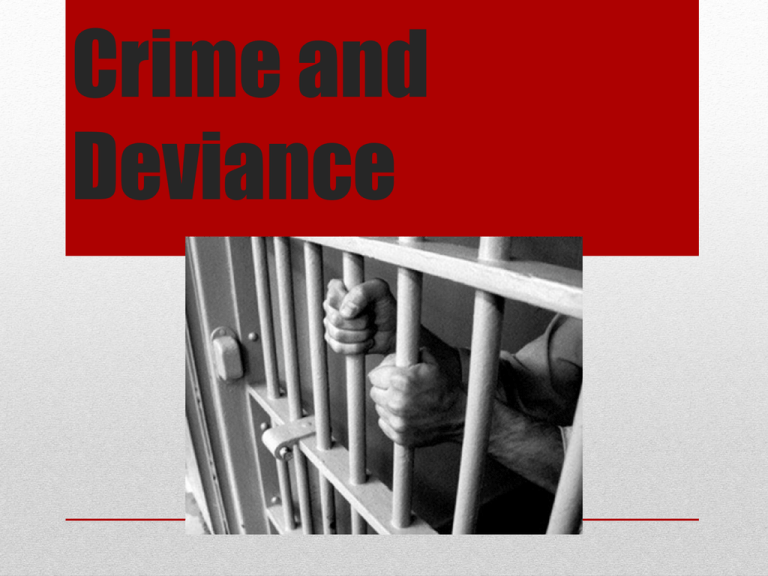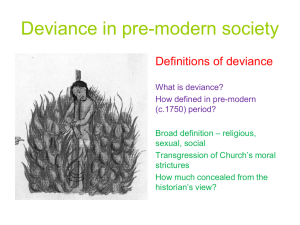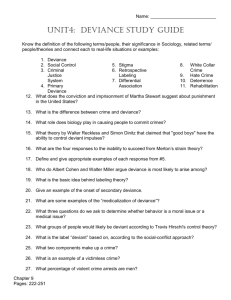File
advertisement

Crime and Deviance How do societies determine what behaviour is acceptable and unacceptable? As we have discussed, all societies have norms that govern acceptable behaviour. If we are to live and work with others, these rules are necessary. What is the difference between Crime and Deviance? Crime and Deviance • A Crime is any act which breaks the formal, written laws of a state. Can you think of examples, and what formal sanctions (or punishments) await those involved in either committing a crime, or allowing such acts to take place? • Deviance is any act that breaks society’s unwritten rules, or expected ‘norms’ of behaviour. In other words, non-conformist behaviour. Can you think of examples of these, and what informal sanctions may await those who transgress? • Crime is referred to as Formal Deviance and Deviance’ is referred to as Informal Deviance Crime and Deviance Crime Examples Deviance Examples • • • • • • • • • • Yelling in Public • Dying your hair purple • Wearing sweatpants (24-7) • Teenage Pregnancy • Tattoos on your FACE • Teacher telling a dirty joke • Teacher smoking a cigarette!? • Refusing to bathe… • LYING? (The stronger the reaction (and more hostile) to the behaviour, the more deviant the action!) Murder! Stealing Indecent Exposure Traffic Violations Sale of Illegal Drugs Kidnapping Assault Rape Arson Crime and Deviance Let’s look at the Psychology of Lying…. • Think about two really good truths and a lie ! Keep this to yourself~ Two Truths and Lie • http://liespotting.com/liespotting-basics/quiz/ Testing Your Lie Spotting IQ • FACT: People across the globe express emotions with the same basic facial expressions. Through his groundbreaking research, Paul Ekman disproved earlier theories that human expressions were learned, and instead showed that our facial expressions are innate and universal. • FACT: Humans communicate primarily through body language. It sounds hard to believe at first, but just 7% of how we communicate with each other is through words. • FACT: It’s so difficult to keep a false story going that you’d think it would be easy to catch a liar in the act. We only catch about 50% of lies. We’re terrible at reading facial expressions and body language. And we’re not much better at listening to the words such as word choice, vocal tone and the chronology of stories. Lie Spotting Basics • In a ten minute conversation you are likely to be lied to two to three times. You might not even realize how often the people in your life are being deceitful. • 91% of people lie regularly at home and at work You are lied to… • https://hiveofactivities.wordpress.com/2013/11/11/howto-spot-a-liar/ Let’s see what the FBI looks for … • https://www.youtube.com/watch?v=P_6vDLq64gE • https://www.youtube.com/watch?v=Fkxz0Tvhbd4 (*) • https://www.youtube.com/watch?v=CRv5FQjjWYU How to Spot a Liar! • 1. They change their head position quickly. (The head will be retracted or jerked back, bowed down, or cocked or tilted to the side) • 2. Their breathing changes. (Heavier breathing, shoulders will rise and their voice may get shallow) • 3. They repeat words or phrases. • 4. They provide too much information. • 5. They touch or cover their mouth. • 6. They instinctively cover vulnerable body parts. (Throat, chest, head, or abdomen) • 7. They shuffle their feet • 8. It becomes difficult for them to speak • 9. They stare at you without blinking much. • 10. They tend to point a lot How to Spot a Liar! • Two Truths and lie! Let’s Try Again… • Now that we have looked at it… is lying deviant? Is lying Deviant? Is lying a Crime? • Is it possible for a deviant act to become normal? • Some acts, previously considered deviant and/or criminal, may well become routine and typical in the future (and vice-versa). Any others you can think of?? • There are four specific characteristics that sociologists use to define deviance… • History changes the definition of deviance, so what is considered deviant today may not be deviant tomorrow. • One hundred years ago, it was considered deviant for women to wear trousers. Today, it’s normal for women to dress in pants, even yoga pants. 1. Deviance is Linked to Time. • How we label an issue determines our moral point of view. • Cultural values come from religious, political, economic, or philosophical principles. • In the Netherlands, assisted suicide for the terminally ill, or “mercy killing” is legal within some circumstances. In the US, euthanasia is considered murder and punished accordingly. • Domestic Abuse in some cultures is considered acceptable ! 2. Deviance is Linked to Cultural Values. • You can find deviants in every culture on the planet. • Regardless of what norms a society establishes, you can always find a small number of nonconformists who will break the rules. • Where there is one…there is the other! 3. Deviance is universal. • Each society views actions differently and reinforces different behaviours. • If society tolerates a behavior, it is no longer deviant. • Prohibition in the 1920s and early 30s made drinking alcohol illegal in the United States, but today it is legal (when you are of age). • Who says you have to be 16 to drive? Why is that the magical age? 4. Deviance is a Social Construct. • Make a list of the typical ‘male and ‘female deviant behaviours… • What are women more likely to do…. Deviance and Gender • Statistics indicate that men are more likely to commit crime than women. • For example, in 2012, 80% of known offenders (481,000+) were men…. • Why do you think so ? Statistics Show… • Sex role theory: this theory argues that boys and girls are socialized differently, therefore resulting in boys becoming more delinquent. Firstly, girls are more supervised and more strictly controlled. Secondly, boys are encouraged to take risks and to be tough and aggressive. • Girls have a readily available female role model at home, whereas boys have less access to their male role model as traditionally the father was out of home. Boys will be socialized largely by their mother and will tend to reject behavior that is seen as feminine as they compulsively pursue masculinity. Why is this so? Theories for Crime and Deviance • Motivational Theories Subcultural Social Constructionism Strain Differential Association • Constraint Theory Labelling Control Theory Conflict Theory *Subcultural Theory: deviance is the result of individuals conforming to the values and norms of a social group to which they belong, if you belong to a social group whose norms differ from those of the main society then you will become a deviant. Examples? • *Social Constructionism: natural or innate features of life are often sustained by social processes. It emphasizes that social problems do not emerge spontaneously. Instead, social phenomena are created, institutionalized, and made into tradition by humans. • Social Constructionism is associated with POWER as generally powerful social groups are able to create norms and laws that suit their interests. • *Strain: Strain results when a culture teaches people the value of material success and society fails to provide enough legitimate opportunities for everyone to succeed. Therefore social structures within society may pressure citizens to commit crime. • • • • • The average person is taught to go to school to achieve success The average person is taught to wanting the finer things in life The American dream is not equally distributed Not everyone has the same means of obtaining success The American dream creates crime, as people feel strained and may resort to deviant activities. • *Differential Association: Those who associate with delinquents, deviants, or criminals learn to value deviance. The greater the frequency, duration, and intensity of their immersion in deviant environments, the more likely it is that they will become deviant. • Criminal behavior is learned through interactions with other people Labelling: Assumes that once young people have been labelled as a criminal they are more likely to offend. Generally once they have accepted that role, they seek out others who have also been labelled as a delinquent. Deviance results not so much from the actions of the deviant as from the response of others, who label the rule breaker as deviant. Control Theory: the view that people refrain from deviant behavior because diverse factors control their impulses to break social norms. Some controls are internal, such as a person's conscience and motivation to succeed; others are external, such as one's parents, friends, and legal codes. Conflict Theory: holds that deviance and crime arise out of the conflict between the powerful and less powerful. Conflict theorists maintain that the rich and powerful impose deviant and criminal labels on the less powerful members of society, particularly those who challenge the existing social order. Meanwhile, they are usually able to use their money and influences to escape punishment for their own misdeeds. http://www.cbc.ca/news/canada/the-murderof-reena-virk-and-trials-of-kelly-ellard1.792656 Let’s Look at Stereotypes… Stereotypes… • After hearing the story of Reena Virk, it is easy to see that a way someone looks does not necessarily determine if they are a deviant… • With that said! Let’s look at Physiognomy. (Which does exactly that… looks at faces to determine if people are deviant) Physiognomy Physiognomy • The terms physiognomy and phrenology refer to the study of features of the face and head as used to deduce the characteristics or temperament of an individual. • These features include the shapes and positions of major areas and landmarks of the face, such as the forehead, eyebrows, nose, cheeks, and mouth. Scholarly Journal Article: “THE ACCURACY OF INFERENCES ABOUT CRIMINALITY BASED ON FACIAL APPEARANCE” • Jeffrey M. Valla • Stephen J. Ceci • Wendy M. Williams * Department of Human Development, Cornell University Physiognomy • Across two different sets of criminal/non-criminal stimuli, we found that participants presented with brief exposures to static cropped facial images of convicted criminals and non-criminals were able to reliably distinguish between them. • However, participants were unable to accurately judge more nuanced distinctions of criminality, namely the violent/non-violent status, and the crime committed. CAN YOU TELL?? • • • • • Non-Criminal Arson Assault Drug Dealing Sexual Assault CRIMINAL VS NON CRIMINAL • • • • NON-CRIMINAL: 1, 2, 6 ARSON: 5 ASSAULT: 4 SEXUAL ASSAULT: 3 • • • • • NON-CRIMINAL: 7, 9, 12 ARSON: 10 ASSAULT: DRUG DEALER: 8, 11 SEXUAL ASSAULT: • • • • • NON-CRIMINAL: 13, 14, 15, 17, 18 ARSON: 16 ASSAULT: DRUG DEALER: SEXUAL ASSAULT: • • • • • NON-CRIMINAL: 19, 22 ARSON: 20 ASSAULT: 24 DRUG DEALER: 21 SEXUAL ASSAULT: 23 • • • • • NON-CRIMINAL: 25, 26, 30 ARSON: ASSAULT: 27, 28 DRUG DEALER: 29 SEXUAL ASSAULT: • • • • • NON-CRIMINAL: ARSON: ASSAULT: DRUG DEALER: SEXUAL ASSAULT: 31, 32 • There were problems with the study • And Physiognomy is not accurate most of the time…




